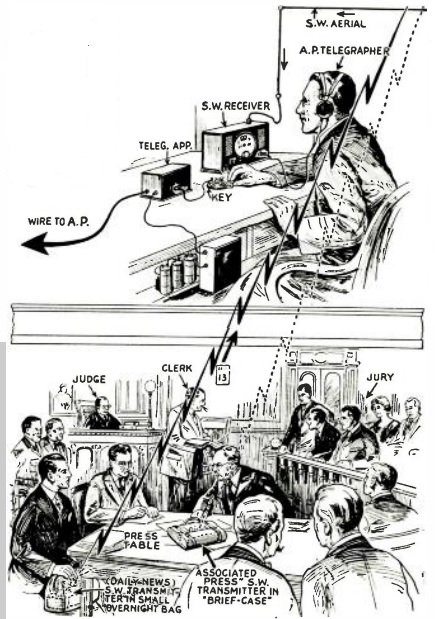 On February 13, 1935, the jury in the Lindbergh kidnapping case returned its verdict, finding Bruno Richard Hauptmann guilty, and recommending the death penalty.
On February 13, 1935, the jury in the Lindbergh kidnapping case returned its verdict, finding Bruno Richard Hauptmann guilty, and recommending the death penalty.
The case was the “crime of the century,” and the reporters present at the trial were eager to scoop their colleauges. The courtroom was locked when the jury returned, but the Associated Press figured out a way to get the news out of the courtroom. Their reporter carried a small transmitter in his briefcase, and upon hearing the verdict, he was to send a prearranged code with the news. A nearby AP telegrapher would be listening, and immediately telegraph the news to AP headquarters.
The code for guilty, but with a recommendation for mercy, meaning life in prison, was four dots. That night, the AP scooped the competition, and radio listeners around the country heard the news that Hauptmann would get life in prison. But unfortunately for the listening public (and for Hauptmann), the verdict was actually guilty of first degree murder, meaning the electric chair. The AP issued a correction a few minutes later.
The little mixup was caused by someone else having the same idea. The New York Daily News also came up with the idea of smuggling a transmitter into the locked courtroom, and the Daily News’ signal of four dots meant merely that the jury had entered the courtroom.
This story was recounted 80 years ago this month in the June 1935 issue of Shortwave Craft magazine. The article is probably written by publisher Hugo Gernsback, and as with most of what he wrote, it contains a good bit of self-promotion. He included the photo of a briefcase shortwave receiver that had been featured in the magazine three years earlier, in the June 1932 issue.
Undaunted by the fact that what he had published had been a receiver, he notes that “with a slight change in the connections, this receiver is easily converted into a transmitter for code signals, such as those used at the Hauptmann trial.”
I haven’t found any corroboration of this incident. Gernsback’s support of his theory comes from his assertion that the reporters in question didn’t deny it when he asked about it. It seems a bit far-fetched, since it depends on both the AP and the Daily News happening to use the same frequency for their clandestine transmitters. Since the transmission would necessarily be so short, it would be imperative for the listener to be tuned to the exact frequency prior to the signal. It seems that the chances of both papers using the same frequency just by chance are pretty slim.
Click Here For Today’s Ripley’s Believe It Or Not Cartoon ![]()

